ROAS is still a go-to metric, but taken in isolation, it can give a distorted view of performance. A campaign might look successful on paper, yet many of its conversions would have happened without the ads. At the same time, a channel showing a “low” ROAS might be crucial for awareness or for driving cross-channel performance.
On top of that, privacy changes and platform silos create gaps and noise that make traditional ROAS even less reliable. To get a clearer view of impact, advanced teams now look beyond surface numbers—focusing on incremental lift, cross-channel context, and real-time automation.
This article explores the limits of traditional ROAS and how you can uncover hidden value.
Key takeaways
- ROAS alone can be misleading as it may hide wasted spend or undervalue essential channels.
- Incremental ROAS helps capture the real lift your ads generate beyond typical last-click metrics.
- Separating branded from non-branded campaign ROAS provides clearer budgeting and performance management insights.
- Systematic creative testing is an effective way to improve ROAS and scale campaigns.
- Automation tools like Bïrch (formerly Revealbot) support dynamic budget and bid adjustments, easing manual workload and enabling timely optimizations.
The cracks in ROAS as a KPI

ROAS can spotlight strong growth on dashboards, but those numbers often hide the weak spots. Discounts can inflate short-term numbers, last-click attribution models skew credit, and signal loss leaves blind spots in reporting. As a KPI, ROAS on its own is a siloed metric that rarely shows the full financial impact.
To truly understand performance, marketers need to dig deeper, considering profitability, long-term value, and the broader financial impact.
ROAS vs ROI: what most marketers get wrong
ROAS shows how much revenue you make for every dollar spent on ads—a snapshot of campaign efficiency.
ROI goes further by factoring in all costs—like production, staffing, platform fees, and overheads—offering a realistic picture of profitability.
For example, a campaign might post a high ROAS, yet erode margins through heavy discounts or drain resources with costly creatives and manual work.
If you only track ROAS, you risk over-investing in tactics that don’t drive sustainable growth. To get the complete financial picture, it helps to look at ROI by:
- Tracking all campaign costs—including creative, platform, and operational—to see the true investment behind your marketing
- Factoring in customer lifetime value (LTV) to understand which channels bring repeat buyers and put acquisition costs into context
- Including margins and discount impacts in ROAS calculations to highlight which campaigns drive profit—not just revenue
- Testing incremental spend scenarios to see where extra budget leads to incremental profit before scaling further
The problem with last-click attribution and signal loss
Traditional last-click attribution skews ROAS by giving full credit to the final touchpoint and isolating channels instead of showing how they work together. It undervalues the influence of upper- and mid-funnel efforts, and can steer spend away from channels essential for long-term growth.
Take iOS campaigns as an example. With ATT opt-outs, many conversions still happen but are not attributed directly to your ads. Platforms fill the gap with modeled data, which often favors channels with more complete tracking—artificially inflating their ROAS.
Signal loss also fragments user data across devices and platforms, leaving blind spots in the customer journey. Early-funnel and offline touchpoints often go untracked, making the channels driving these “hidden” interactions look like they are underperforming in ROAS reports.
The more you rely on modeled data, the more outcomes are guided by assumptions and historical patterns. This reduces precision and makes it harder to optimize campaigns dynamically.
A holistic approach—combining multiple data sources, server-side tracking, and incrementality tests—gives a more complete view of performance.
Incremental ROAS: the smarter way to measure true ad impact
Incremental ROAS measures the actual lift your campaigns generate, rather than the face-value revenue attributed to your ads.
To calculate it, you can use incrementality tests such as geo experiments and holdout groups, which compare exposed audiences with controls to reveal the true impact of spend. These methods cut through overlapping touchpoints, modeled data, and attribution assumptions, showing which campaigns create new value.
Platforms have made this easier. Meta’s Conversion Lift automates test and control groups to measure incremental impact. Google’s Brand Lift surveys expose and control audiences to track awareness and recall.
You can also use platforms like Sellforte and Arymala Labs for marketing mix modeling (MMM). They use advanced analytics and econometrics to integrate marketing data with external factors—such as seasonality and competition—revealing the broader drivers of campaign performance.
Advanced strategies to increase ROAS
Split branded and non-branded campaigns to reveal true performance
Combining branded and non-branded results into one ROAS figure can sometime es inflate perceived efficiency and hide underperformance in non-branded campaigns.
- Branded campaigns usually deliver much higher ROAS because they reach users who are familiar with your brand and closer to purchase. They have higher conversion rates, stronger intent, and lower CPCs.
- Non-branded campaigns are critical for growth as they expand reach to new audiences. However, they are less efficient, often with higher CPCs and lower conversion rates.
In one B2B study by Dreamdata, branded Google Search terms delivered a striking 1299% ROAS compared to just 68% for non-branded campaigns—despite marketers allocating 82% of their budget to non-branded terms.
Keeping these campaign types separate lets you optimize budgets strategically—supporting branded campaigns to protect market position while testing and scaling non-branded campaigns to drive long-term growth.
Use cross-platform attribution to uncover hidden value
Cross-platform attribution connects touchpoints across devices and channels, linking activity to a single user through logins or device IDs. It exposes the incremental value of campaigns that build awareness or assist conversions but rarely get credit under last-click models.
For instance, a customer might see an Instagram ad, then click on an email, and finally convert after a retargeted Google ad.
Capturing the complete journey reveals how these channels reinforce each other, helping you optimize spend, reduce waste, and double down on the campaigns that drive impact across your mix.
Automate budget pacing and rules to prevent overspend
Manual budget management can make it challenging to react to real-time performance changes, wasting spend and leading to missed opportunities.
Automation tools let you set pacing rules and adaptive budgets based on live ROAS data, automatically reallocating spend, adjusting bids, and pausing underperforming ads to keep your campaigns efficient.
For example, e-commerce brand Cocosolis uses Bïrch’s automation for Meta and TikTok to scale campaigns quickly while controlling target ROAS.
They set up ROAS-focused rules tailored to each account’s goals and apply them at the campaign, ad set, and ad level. These rules include time-of-day optimization to align performance across markets and delayed attribution recovery to restart ads when ROAS improves after attribution delays.

This automation saves Cocosolis up to 102 hours each month, enables consistent strategies across more than 20 ad accounts, reduces waste spend, and triggers over 29,000 automated actions. It lets the team adapt instantly to shifts in user behavior and peak activity times without manual effort.
Test creative systematically as the biggest ROAS lever
Targeting and bidding are becoming more precise and competitive. This means creative is taking on an even bigger role in performance, often driving the biggest swings in outcomes.
Strong creative not only lifts conversions but also builds long-term engagement—signals that matter more than a single ROAS snapshot. Systematic creative testing lets you separate what looks efficient in dashboards from what truly delivers results, ensuring you scale campaigns on reliable insights rather than misleading metrics.
Key areas to test include:
- Headlines and messaging: Test different value propositions, emotional triggers, and tones to see what captures attention and motivates action. For instance, compare “Free trial” against “Try free for 30 days” while keeping visuals constant.
- Visuals: Play around with images, color schemes, and layouts. Comparing product-focused images to lifestyle scenarios can show which resonates more.
- Copy length and tone: Experiment with concise and detailed messaging to find out which generates more engagement.
- CTAs: Try different wording, placement, and button designs, such as “Buy now” versus “Get started,” to see what boosts conversions.
Link ROAS to retention and customer lifetime value
Connecting ROAS with LTV highlights the broader impact of your campaigns and helps you prove ROI. Customers who generate 3x ROAS on their first purchase may deliver 10x or more over a year through repeat buying.
Retention strategies such as personalized emails, loyalty programs, and post-purchase follow-up help cement long-term returns. Factoring in LTV also reduces reliance on short-term tactics, like discounting, that improve immediate ROAS but weaken margins.
Here are some effective approaches:
- Segmenting audiences by predicted LTV to identify customers with the highest potential value, informing bidding and campaign focus.
- Tracking retention metrics to distinguish one-time buyers from long-term customers and evaluate customer quality.
- Balancing acquisition and retention spend to support sustainable growth while protecting profitability.
Automating ROAS optimization with Bïrch
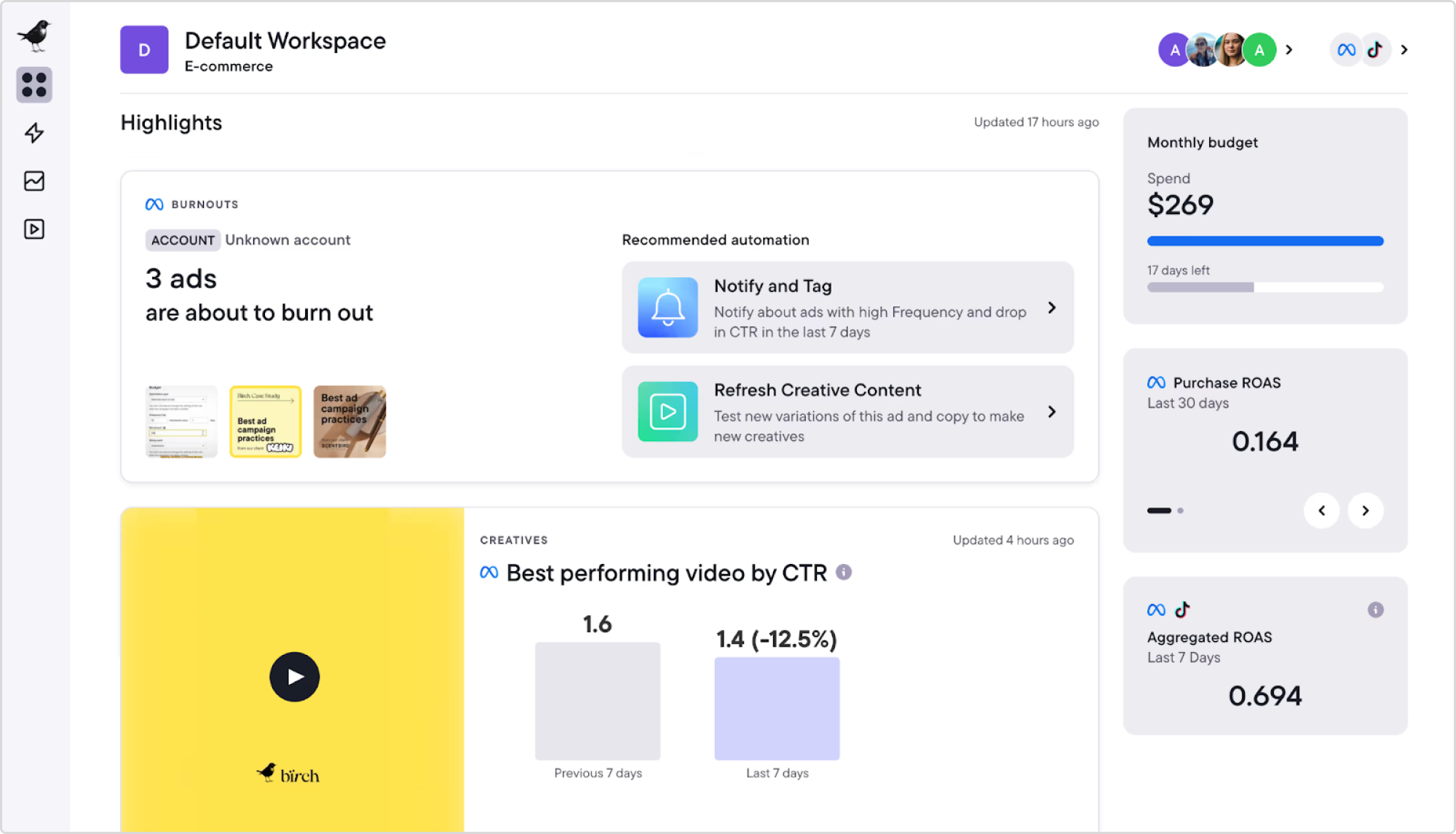
Bïrch supports automation across Meta, Google Ads, TikTok, and Snapchat, bringing all your campaigns into a single workspace.
On the main dashboard, you can set Purchase ROAS as your primary target KPI, giving a clear overview of total performance across accounts. This helps your team stay focused on the main goal over a chosen period.
Automation then takes over routine optimization: rules can pause underperforming ads, scale budgets, or trigger alerts based on ROAS thresholds.
Combining high-level visibility with automated actions keeps performance steady and budgets flexible—freeing you to focus on strategy and creative growth rather than daily manual checks.
Step 1: Setting ROAS goals for automation inside Bïrch
Bïrch lets you set ROAS targets at multiple levels—campaign, ad set, and individual ads—so you can tailor monitoring and automation to your strategy.
You can use the platform-native ROAS from Facebook, TikTok, or other supported networks. But if your workflow needs something more custom—like a unique formula for revenue per ad dollar spent or a blended performance metric—you can create a custom metric.
Here’s how:
- Go to Custom metrics tab on the Automated rules page
- Click “New custom metric” and enter your ROAS formula or target value.
- Save the metric for later use in rule automation.
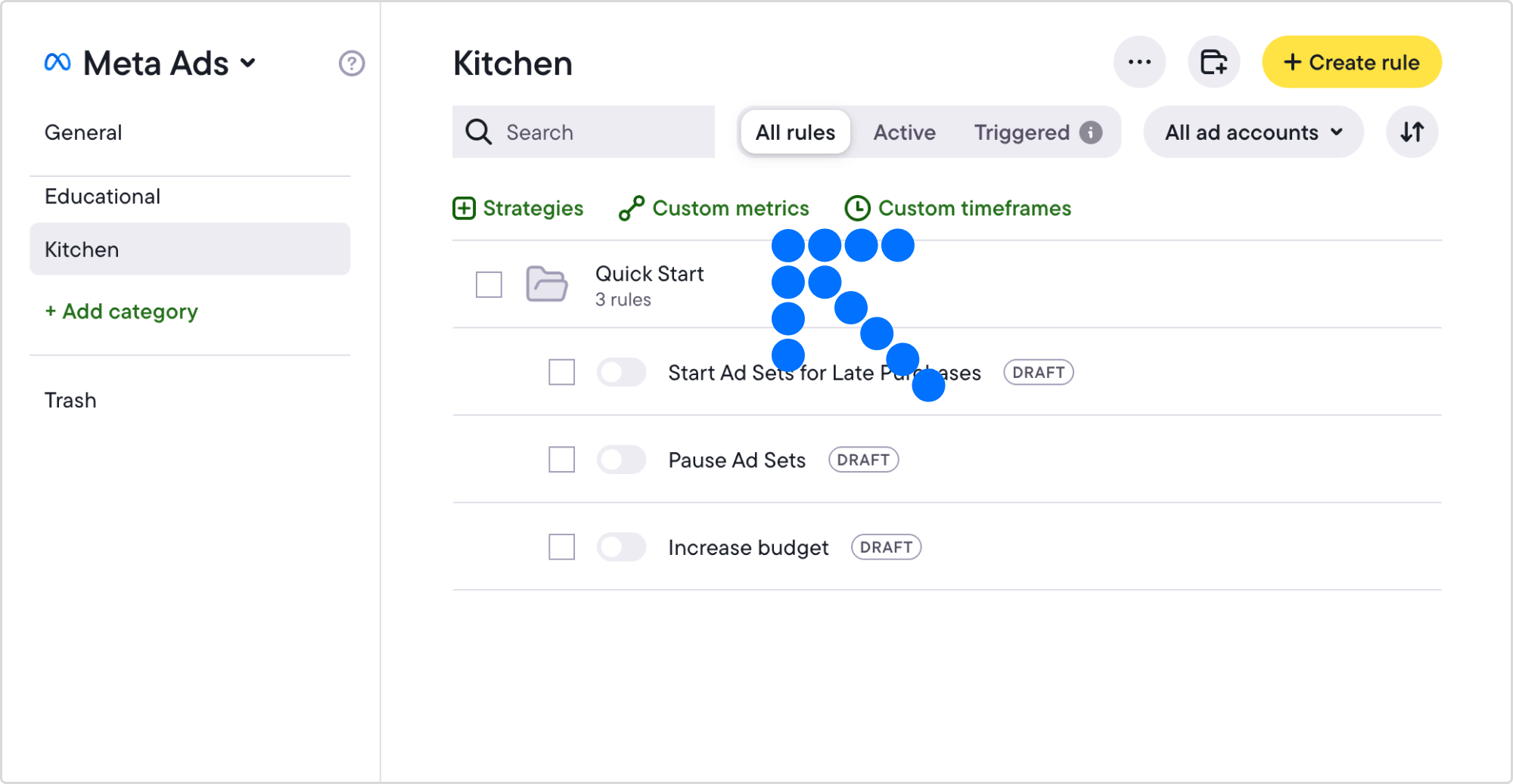
Pro tip: You can mix regular metrics, numbers, Google Sheets-based metrics, and data from Wicked Reports and Hyros in your custom metric to get the combination that works for your workflow.
Step 2: Building rules for budget reallocation and bid adjustments
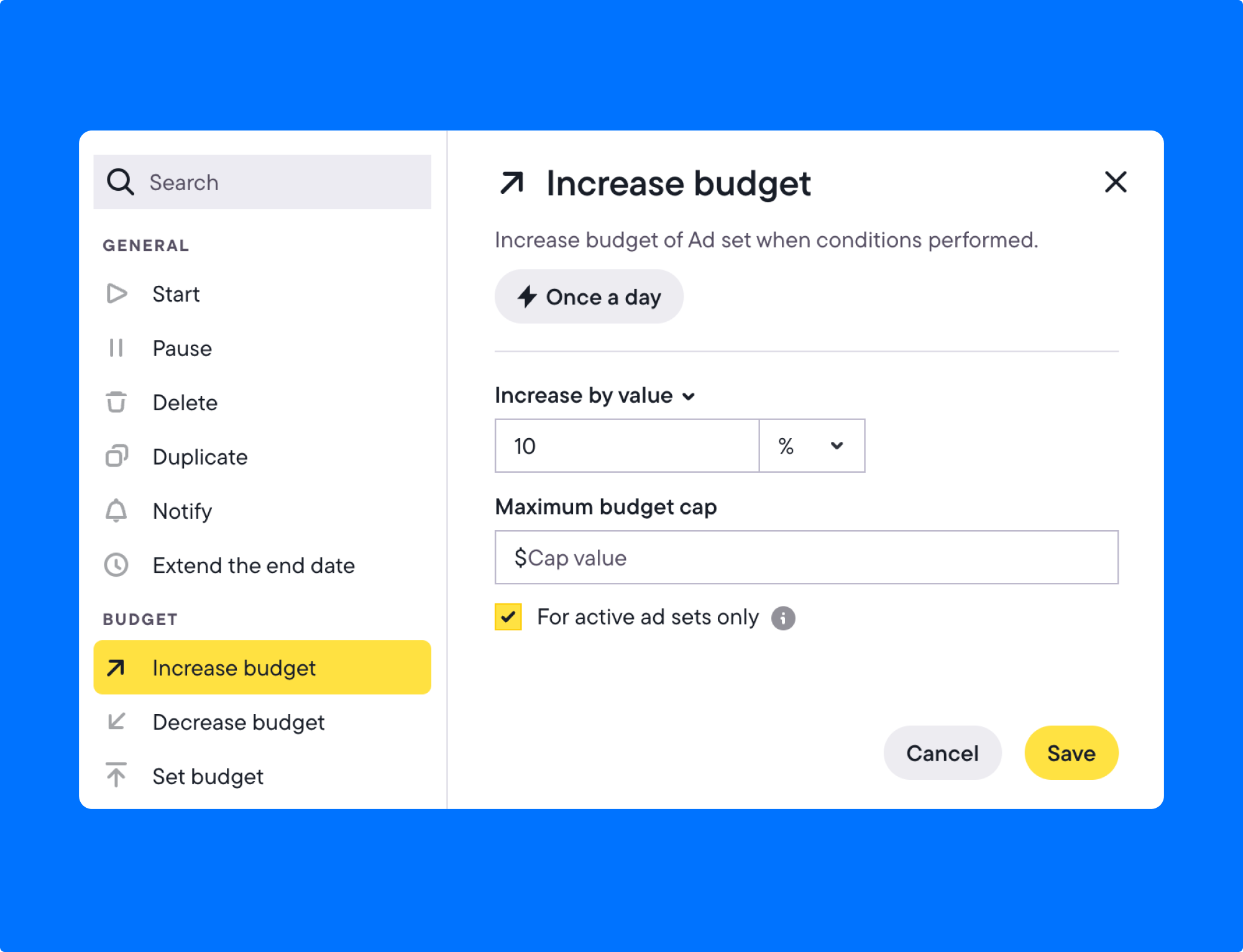
Once you have set the goals, consider rules that adjust budgets or bids automatically based on performance.
For example, Bïrch offers “increase budget” rules to expand spend when ROAS is strong, and “pause” rules to halt campaigns when performance dips.
- Open the Automation rules builder and select the ad platform.
- Choose to build a rule from scratch or from a template.
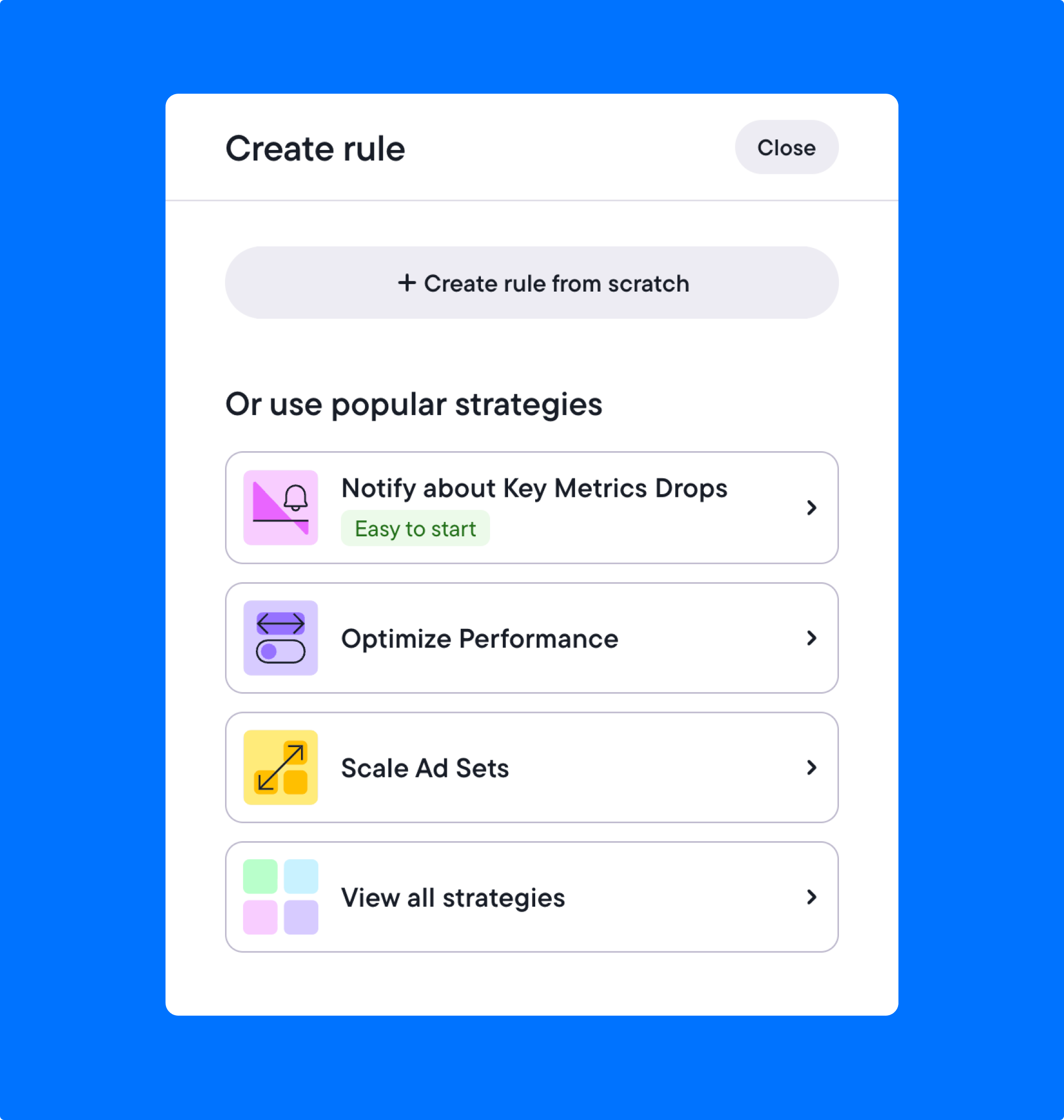
- Give the rule a descriptive name (e.g., “Increase budget if performance is strong”) and a short description.
- Select up to five ad accounts for the rule (duplicate later for more accounts if needed).
- Define what the rule applies to: campaigns, ad sets, or ads.
- Click + to add filters: filter by name, status, objective, delivery, or performance metrics.
- Choose the action, such as increasing the daily budget by 20% (you can select percentage, fixed value, or custom metric). You can also choose to set a maximum budget cap.
- Add conditions such as “ROAS > [target]” or “ROAS < [threshold].”
- Configure how often the rule checks for conditions by setting its run frequency (e.g., every 15 minutes, daily, or up to every 72 hours).
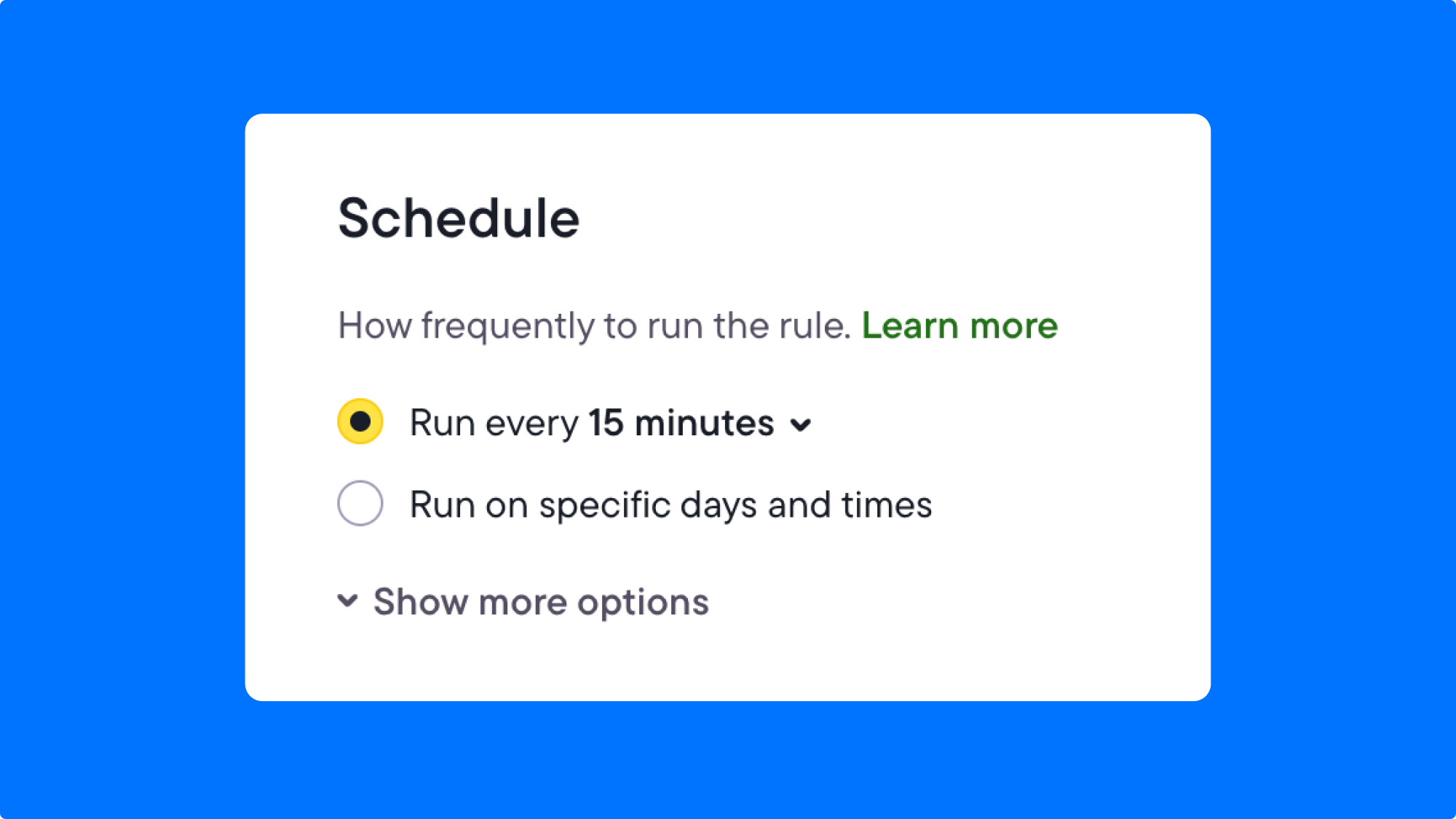
Pro tip: Exploring the Double-down strategy can be helpful if you’re looking to scale efficiently after automating budgets and bids. It copies top-performing campaigns and increases budgets based on ROAS signals.
Step 3: Using alerts to catch ROAS drops in real time
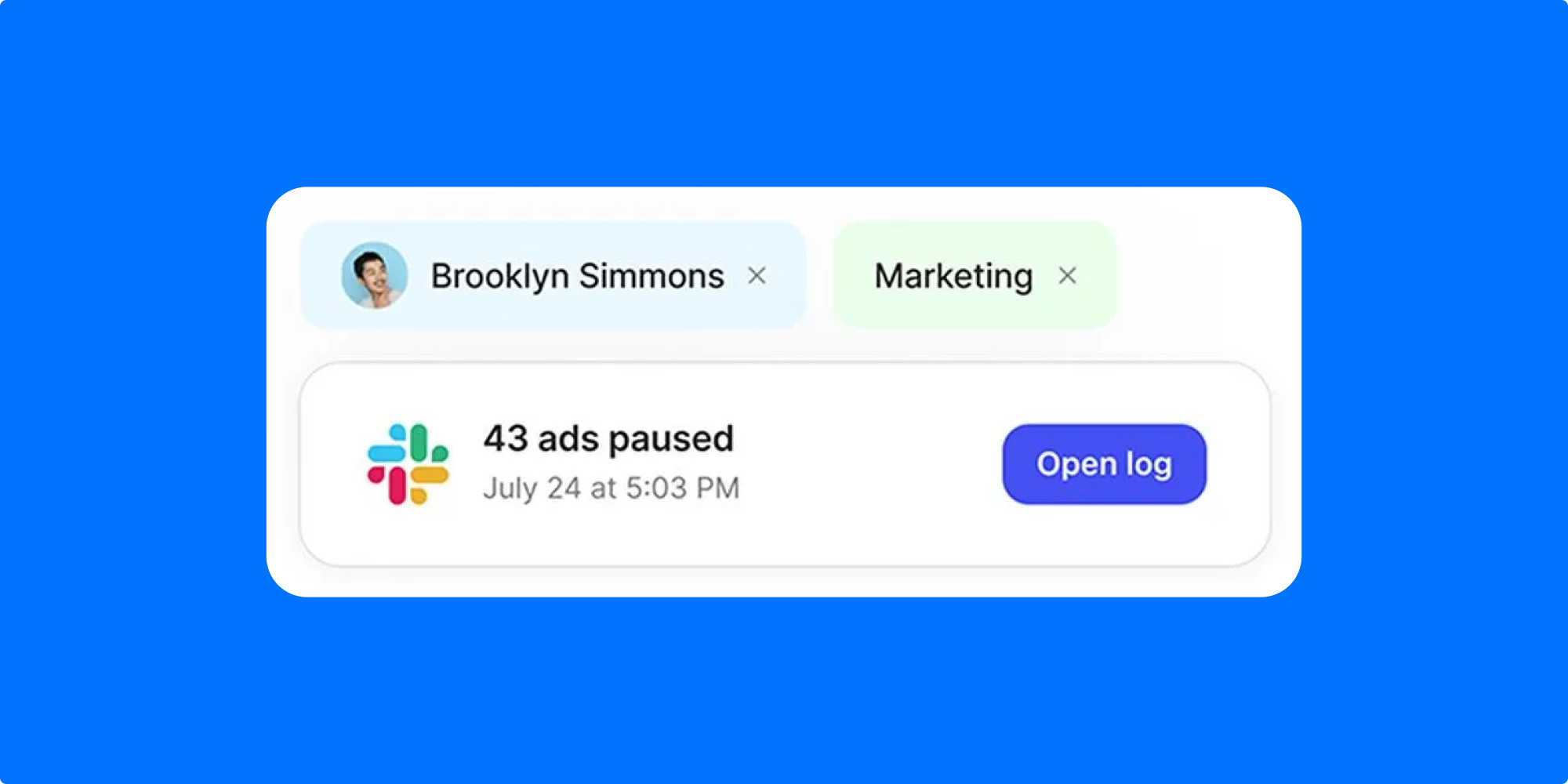
You can set up Slack or email alerts through Bïrch to keep you instantly aware of performance changes, budget issues, or pacing deviations across campaigns and platforms.
- Schedule alerts for the hours that suit you (e.g., 6 a.m. to 6 p.m.) or as certain conditions are met.
- Add as many alert recipients as you need, whether Slack channels or email addresses. You can choose whether you want all notifications or just error alerts.
- Confirm your preferred timezone (defaults to the ad account timezone), ensuring alerts and execution times align with your reporting.
- Customize the attribution window if needed for conversion logic (we recommend keeping the default unless required).
Pro tip: Automatically add 🔥 and ❌ emojis to your ad set names in Bïrch using automation rules—quickly flagging high- and low-ROAS performers at a glance. The system updates emoji tags based on performance, then removes them when ROAS criteria change, so your naming conventions always reflect live results.
Smarter ROAS for advanced marketers

ROAS can still be useful, but on its own, it’s a narrow KPI. Last-click attribution and signal loss can make results look stronger than they are—but looking past surface-level returns reveals the true picture.
Measuring incremental ROAS gives a clearer view, highlighting which investments drive new revenue instead of just shifting existing sales.
Beyond measurement, advanced teams are using creative testing to optimize performance and automation to close the gap between insight and execution.
With Bïrch, tools like personalized and automated bid rules, creative performance analysis, and timely alerts come together—helping you scale with confidence while staying on top of the metrics that matter.
FAQs
ROAS is still a go-to metric, but taken in isolation, it can give a distorted view of performance. A campaign might look successful on paper, yet many of its conversions would have happened without the ads. At the same time, a channel showing a “low” ROAS might be crucial for awareness or for driving cross-channel performance.
On top of that, privacy changes and platform silos create gaps and noise that make traditional ROAS even less reliable. To get a clearer view of impact, advanced teams now look beyond surface numbers—focusing on incremental lift, cross-channel context, and real-time automation.
This article explores the limits of traditional ROAS and how you can uncover hidden value.
Key takeaways
- ROAS alone can be misleading as it may hide wasted spend or undervalue essential channels.
- Incremental ROAS helps capture the real lift your ads generate beyond typical last-click metrics.
- Separating branded from non-branded campaign ROAS provides clearer budgeting and performance management insights.
- Systematic creative testing is an effective way to improve ROAS and scale campaigns.
- Automation tools like Bïrch (formerly Revealbot) support dynamic budget and bid adjustments, easing manual workload and enabling timely optimizations.
The cracks in ROAS as a KPI

ROAS can spotlight strong growth on dashboards, but those numbers often hide the weak spots. Discounts can inflate short-term numbers, last-click attribution models skew credit, and signal loss leaves blind spots in reporting. As a KPI, ROAS on its own is a siloed metric that rarely shows the full financial impact.
To truly understand performance, marketers need to dig deeper, considering profitability, long-term value, and the broader financial impact.
ROAS vs ROI: what most marketers get wrong
ROAS shows how much revenue you make for every dollar spent on ads—a snapshot of campaign efficiency.
ROI goes further by factoring in all costs—like production, staffing, platform fees, and overheads—offering a realistic picture of profitability.
For example, a campaign might post a high ROAS, yet erode margins through heavy discounts or drain resources with costly creatives and manual work.
If you only track ROAS, you risk over-investing in tactics that don’t drive sustainable growth. To get the complete financial picture, it helps to look at ROI by:
- Tracking all campaign costs—including creative, platform, and operational—to see the true investment behind your marketing
- Factoring in customer lifetime value (LTV) to understand which channels bring repeat buyers and put acquisition costs into context
- Including margins and discount impacts in ROAS calculations to highlight which campaigns drive profit—not just revenue
- Testing incremental spend scenarios to see where extra budget leads to incremental profit before scaling further
The problem with last-click attribution and signal loss
Traditional last-click attribution skews ROAS by giving full credit to the final touchpoint and isolating channels instead of showing how they work together. It undervalues the influence of upper- and mid-funnel efforts, and can steer spend away from channels essential for long-term growth.
Take iOS campaigns as an example. With ATT opt-outs, many conversions still happen but are not attributed directly to your ads. Platforms fill the gap with modeled data, which often favors channels with more complete tracking—artificially inflating their ROAS.
Signal loss also fragments user data across devices and platforms, leaving blind spots in the customer journey. Early-funnel and offline touchpoints often go untracked, making the channels driving these “hidden” interactions look like they are underperforming in ROAS reports.
The more you rely on modeled data, the more outcomes are guided by assumptions and historical patterns. This reduces precision and makes it harder to optimize campaigns dynamically.
A holistic approach—combining multiple data sources, server-side tracking, and incrementality tests—gives a more complete view of performance.
Incremental ROAS: the smarter way to measure true ad impact
Incremental ROAS measures the actual lift your campaigns generate, rather than the face-value revenue attributed to your ads.
To calculate it, you can use incrementality tests such as geo experiments and holdout groups, which compare exposed audiences with controls to reveal the true impact of spend. These methods cut through overlapping touchpoints, modeled data, and attribution assumptions, showing which campaigns create new value.
Platforms have made this easier. Meta’s Conversion Lift automates test and control groups to measure incremental impact. Google’s Brand Lift surveys expose and control audiences to track awareness and recall.
You can also use platforms like Sellforte and Arymala Labs for marketing mix modeling (MMM). They use advanced analytics and econometrics to integrate marketing data with external factors—such as seasonality and competition—revealing the broader drivers of campaign performance.
Advanced strategies to increase ROAS
Split branded and non-branded campaigns to reveal true performance
Combining branded and non-branded results into one ROAS figure can sometime es inflate perceived efficiency and hide underperformance in non-branded campaigns.
- Branded campaigns usually deliver much higher ROAS because they reach users who are familiar with your brand and closer to purchase. They have higher conversion rates, stronger intent, and lower CPCs.
- Non-branded campaigns are critical for growth as they expand reach to new audiences. However, they are less efficient, often with higher CPCs and lower conversion rates.
In one B2B study by Dreamdata, branded Google Search terms delivered a striking 1299% ROAS compared to just 68% for non-branded campaigns—despite marketers allocating 82% of their budget to non-branded terms.
Keeping these campaign types separate lets you optimize budgets strategically—supporting branded campaigns to protect market position while testing and scaling non-branded campaigns to drive long-term growth.
Use cross-platform attribution to uncover hidden value
Cross-platform attribution connects touchpoints across devices and channels, linking activity to a single user through logins or device IDs. It exposes the incremental value of campaigns that build awareness or assist conversions but rarely get credit under last-click models.
For instance, a customer might see an Instagram ad, then click on an email, and finally convert after a retargeted Google ad.
Capturing the complete journey reveals how these channels reinforce each other, helping you optimize spend, reduce waste, and double down on the campaigns that drive impact across your mix.
Automate budget pacing and rules to prevent overspend
Manual budget management can make it challenging to react to real-time performance changes, wasting spend and leading to missed opportunities.
Automation tools let you set pacing rules and adaptive budgets based on live ROAS data, automatically reallocating spend, adjusting bids, and pausing underperforming ads to keep your campaigns efficient.
For example, e-commerce brand Cocosolis uses Bïrch’s automation for Meta and TikTok to scale campaigns quickly while controlling target ROAS.
They set up ROAS-focused rules tailored to each account’s goals and apply them at the campaign, ad set, and ad level. These rules include time-of-day optimization to align performance across markets and delayed attribution recovery to restart ads when ROAS improves after attribution delays.

This automation saves Cocosolis up to 102 hours each month, enables consistent strategies across more than 20 ad accounts, reduces waste spend, and triggers over 29,000 automated actions. It lets the team adapt instantly to shifts in user behavior and peak activity times without manual effort.
Test creative systematically as the biggest ROAS lever
Targeting and bidding are becoming more precise and competitive. This means creative is taking on an even bigger role in performance, often driving the biggest swings in outcomes.
Strong creative not only lifts conversions but also builds long-term engagement—signals that matter more than a single ROAS snapshot. Systematic creative testing lets you separate what looks efficient in dashboards from what truly delivers results, ensuring you scale campaigns on reliable insights rather than misleading metrics.
Key areas to test include:
- Headlines and messaging: Test different value propositions, emotional triggers, and tones to see what captures attention and motivates action. For instance, compare “Free trial” against “Try free for 30 days” while keeping visuals constant.
- Visuals: Play around with images, color schemes, and layouts. Comparing product-focused images to lifestyle scenarios can show which resonates more.
- Copy length and tone: Experiment with concise and detailed messaging to find out which generates more engagement.
- CTAs: Try different wording, placement, and button designs, such as “Buy now” versus “Get started,” to see what boosts conversions.
Link ROAS to retention and customer lifetime value
Connecting ROAS with LTV highlights the broader impact of your campaigns and helps you prove ROI. Customers who generate 3x ROAS on their first purchase may deliver 10x or more over a year through repeat buying.
Retention strategies such as personalized emails, loyalty programs, and post-purchase follow-up help cement long-term returns. Factoring in LTV also reduces reliance on short-term tactics, like discounting, that improve immediate ROAS but weaken margins.
Here are some effective approaches:
- Segmenting audiences by predicted LTV to identify customers with the highest potential value, informing bidding and campaign focus.
- Tracking retention metrics to distinguish one-time buyers from long-term customers and evaluate customer quality.
- Balancing acquisition and retention spend to support sustainable growth while protecting profitability.
Automating ROAS optimization with Bïrch

Bïrch supports automation across Meta, Google Ads, TikTok, and Snapchat, bringing all your campaigns into a single workspace.
On the main dashboard, you can set Purchase ROAS as your primary target KPI, giving a clear overview of total performance across accounts. This helps your team stay focused on the main goal over a chosen period.
Automation then takes over routine optimization: rules can pause underperforming ads, scale budgets, or trigger alerts based on ROAS thresholds.
Combining high-level visibility with automated actions keeps performance steady and budgets flexible—freeing you to focus on strategy and creative growth rather than daily manual checks.
Step 1: Setting ROAS goals for automation inside Bïrch
Bïrch lets you set ROAS targets at multiple levels—campaign, ad set, and individual ads—so you can tailor monitoring and automation to your strategy.
You can use the platform-native ROAS from Facebook, TikTok, or other supported networks. But if your workflow needs something more custom—like a unique formula for revenue per ad dollar spent or a blended performance metric—you can create a custom metric.
Here’s how:
- Go to Custom metrics tab on the Automated rules page
- Click “New custom metric” and enter your ROAS formula or target value.
- Save the metric for later use in rule automation.

Pro tip: You can mix regular metrics, numbers, Google Sheets-based metrics, and data from Wicked Reports and Hyros in your custom metric to get the combination that works for your workflow.
Step 2: Building rules for budget reallocation and bid adjustments

Once you have set the goals, consider rules that adjust budgets or bids automatically based on performance.
For example, Bïrch offers “increase budget” rules to expand spend when ROAS is strong, and “pause” rules to halt campaigns when performance dips.
- Open the Automation rules builder and select the ad platform.
- Choose to build a rule from scratch or from a template.

- Give the rule a descriptive name (e.g., “Increase budget if performance is strong”) and a short description.
- Select up to five ad accounts for the rule (duplicate later for more accounts if needed).
- Define what the rule applies to: campaigns, ad sets, or ads.
- Click + to add filters: filter by name, status, objective, delivery, or performance metrics.
- Choose the action, such as increasing the daily budget by 20% (you can select percentage, fixed value, or custom metric). You can also choose to set a maximum budget cap.
- Add conditions such as “ROAS > [target]” or “ROAS < [threshold].”
- Configure how often the rule checks for conditions by setting its run frequency (e.g., every 15 minutes, daily, or up to every 72 hours).

Pro tip: Exploring the Double-down strategy can be helpful if you’re looking to scale efficiently after automating budgets and bids. It copies top-performing campaigns and increases budgets based on ROAS signals.
Step 3: Using alerts to catch ROAS drops in real time

You can set up Slack or email alerts through Bïrch to keep you instantly aware of performance changes, budget issues, or pacing deviations across campaigns and platforms.
- Schedule alerts for the hours that suit you (e.g., 6 a.m. to 6 p.m.) or as certain conditions are met.
- Add as many alert recipients as you need, whether Slack channels or email addresses. You can choose whether you want all notifications or just error alerts.
- Confirm your preferred timezone (defaults to the ad account timezone), ensuring alerts and execution times align with your reporting.
- Customize the attribution window if needed for conversion logic (we recommend keeping the default unless required).
Pro tip: Automatically add 🔥 and ❌ emojis to your ad set names in Bïrch using automation rules—quickly flagging high- and low-ROAS performers at a glance. The system updates emoji tags based on performance, then removes them when ROAS criteria change, so your naming conventions always reflect live results.
Smarter ROAS for advanced marketers

ROAS can still be useful, but on its own, it’s a narrow KPI. Last-click attribution and signal loss can make results look stronger than they are—but looking past surface-level returns reveals the true picture.
Measuring incremental ROAS gives a clearer view, highlighting which investments drive new revenue instead of just shifting existing sales.
Beyond measurement, advanced teams are using creative testing to optimize performance and automation to close the gap between insight and execution.
With Bïrch, tools like personalized and automated bid rules, creative performance analysis, and timely alerts come together—helping you scale with confidence while staying on top of the metrics that matter.
FAQs

You can calculate ROAS by dividing the revenue generated from your ads by the amount spent on those ads: ROAS = revenue from ads / ad spend. For example, if you spent $5,000 on ads and generated $20,000 in revenue, your ROAS is 4. It means you earned $4 for every $1 spent.

In Excel, you can calculate ROAS by dividing the total revenue cell by the total cost cell using a formula like =Revenue/Cost. You can extend this with pivot tables or filters for granular ROAS by campaign or channel.

Target ROAS is a bidding strategy in Google Ads that allows you to set a desired return on ad spend. Google then automatically adjusts bids to help reach that ROAS target, aiming to maximize conversion value while staying within your goal.

A good ROAS depends on your business model and costs. While many often cite a 4:1 ratio (earning $4 for every $1 spent), some businesses require a higher or lower ROAS to achieve profitability. Instead of fixating on one number, you should consider ROAS in the context of customer lifetime value, margins, and your strategic goals.

ROAS measures immediate revenue from ad spend but doesn’t capture longer-term value from repeat purchases or customer loyalty. Linking ROAS with retention and LTV helps you see actual marketing impact beyond the first sale, guiding smarter budget decisions.

Incremental ROAS accounts for the additional revenue your ads generate beyond what would have happened without them. It helps avoid overestimating performance and lets you allocate budget to campaigns driving real growth.

Automation lets you set rules and alerts to adjust budgets, bids, and pause underperforming ads based on real-time ROAS signals. It reduces manual effort and helps keep campaigns aligned with your goals amid changing market conditions.

Yes, calculating blended ROAS across platforms gives a broader picture, but it can mask underperformance in segments. Splitting branded versus non-branded campaigns, or channel-level ROAS, helps reveal actual performance and informs smarter spend allocation.

Revealbot has a new look and a new name—we’re now Bïrch! The change highlights our focus on bringing together the best of automation and creative teamwork.






